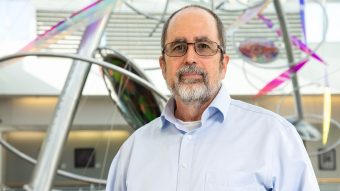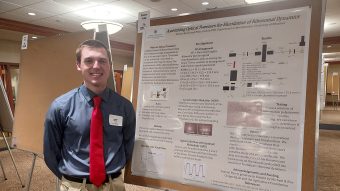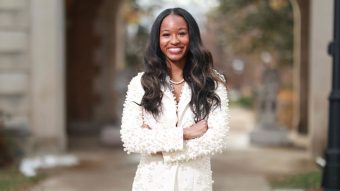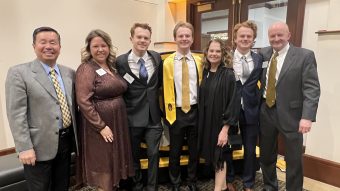April 10, 2023
Contact: Marcus Wilkins, wilkinsm@missouri.edu
As a starry-eyed boy in 1969, Sethuraman Panchanathan’s imagination lingered in the stratosphere. But it was the tangible nature of moonrocks — via an Apollo 11 exhibition in his hometown of Chennai, India — that sparked the 8-year-old’s scientific ambition and set the future National Science Foundation (NSF) director’s course for even loftier heights.
“I was absolutely transfixed by the idea that humans could design and execute a mission to the moon, get these rocks and bring them back,” Panchanathan said. “I would go on to develop a passion for innovation in graduate school.”
Now in his third year as director of the NSF — the independent U.S. agency that supports research and education in the nonmedical fields of science and engineering — Panchanathan exudes enthusiasm. He has also served as executive vice president of the Arizona State University Knowledge Enterprise, where he founded the Center for Cognitive Ubiquitous Computing.
As the inaugural speaker of the President’s Distinguished Lecture Series, Panchanathan will deliver his presentation “Innovation Anywhere, Opportunities Everywhere: Accelerating the Frontiers of Science and Technology” at 10 a.m. Monday, April 24, at Monsanto Auditorium in the Bond Life Sciences Center. The event is free and open to the public, but there is limited seating. Please RSVP by April 14.
Read on for a Q&A with Panchanathan.
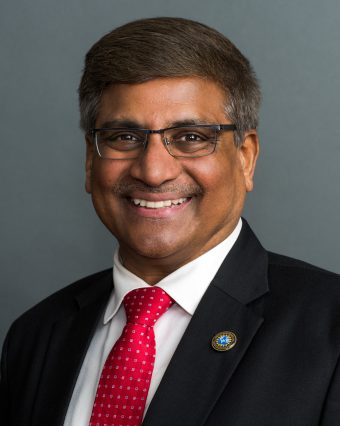
Can you give us an overview of what your presentation to Mizzou will be?
For over seven decades, NSF has been strategically investing in researchers, infrastructure, and programs that are expanding the frontiers of discovery and innovation. The incredible talent and amazing ideas right here in the “Show-Me” state are a testimony to the rich outcomes. The state of Missouri, true to its name, is showing the country the power of synergy between curiosity-driven research and technology and innovation. During my visit, I plan to highlight the work being done at speed and scale across the nation and NSF's plan to ensure that innovation can happen anywhere and opportunities exist everywhere.
Why is it critical that institutions like MU provide an environment that encourages creativity and innovative spirit among faculty and students?
STEM education is the foundation of U.S. leadership in science and technology and must be one of our highest national priorities. Today’s knowledge-intensive economy requires STEM focused innovators and practitioners who are vital for advancing U.S. competitiveness. This means recognizing that STEM skills are critical for jobs of tomorrow and that workers will deploy their innovative skills to constantly adapt to changing needs in the workplace. Our economy is dynamic, and the jobs of today will not necessarily be the jobs of tomorrow. Equipping people at all stages of their education and career with the skills they need to adapt and innovate will ensure our national prosperity.
For many years, NSF has invested in enhancing the teaching of science, technology, engineering and mathematics to students at both undergraduate and graduate levels. This is not just to facilitate the creation of “skill sets” in the workforce of tomorrow but also to provide young people with the “mindsets” and understanding of the importance of high-tech in all aspects of their personal and professional lives.
As a teacher, how do you motivate your students to reach higher and farther?
I encourage my students to keep an open mind and to engage their curiosity to know more about science. My advice to every student is to be an explorer: Always ask questions. You will find that your natural curiosities will automatically lead you to pathways that you would have never imagined. You have to experiment and learn as well as you have to experience it. I strongly believe that when you let people express their creativity and passion in whatever discipline they want to pursue, they will make significant contributions to society and be successful.
What is your advice to researchers as they pursue NSF funding?
My best advice to researchers thinking about how to get NSF funding is to reach out to an NSF program officer as the first step in the application process. It is always a good idea to speak with program officers, as they can provide insight and often give direct feedback and can provide general advice on writing proposals for NSF and tell you if your idea is a good fit for their specific program.
Here are five tips on how to work with an NSF program officer. Our NSF 101 informational series also provides answers to commonly asked questions for applicants who might be new to applying for NSF funding.
